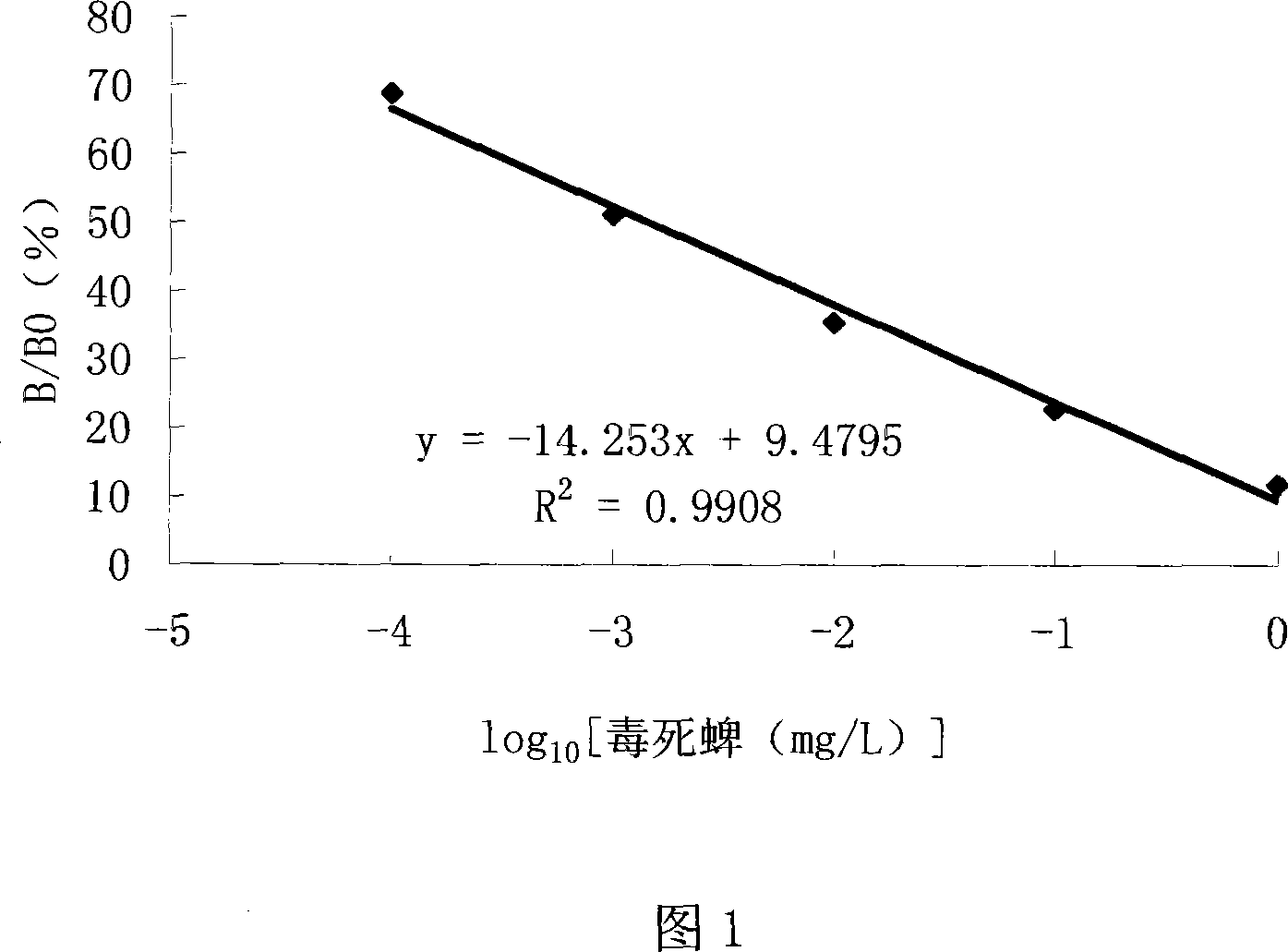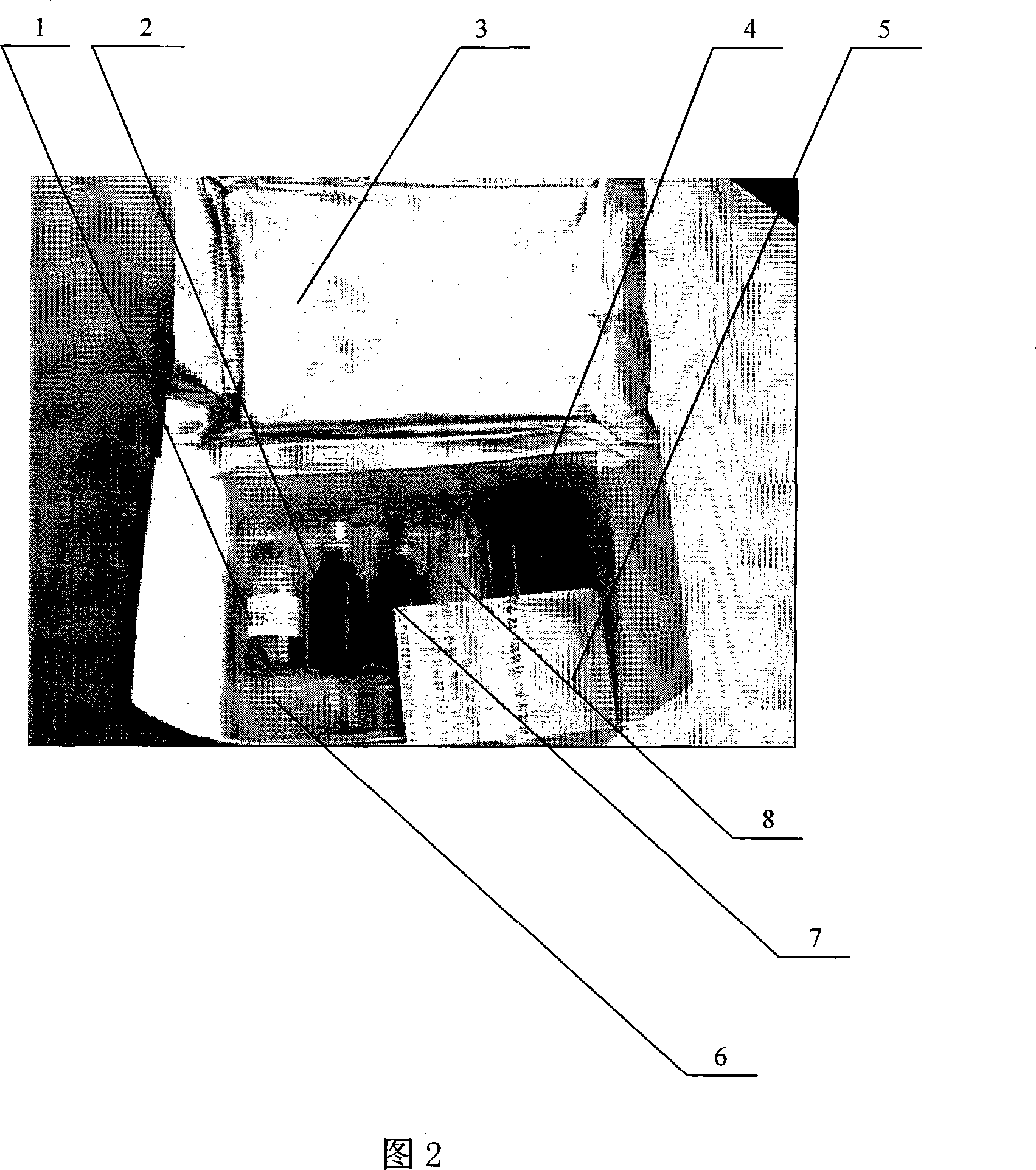ELISA kit for detecting chlopyrifos residue and method of use thereof
An enzyme-linked immunosorbent reagent, chlorpyrifos technology, applied in the direction of measuring devices, instruments, scientific instruments, etc., can solve the problems of time-consuming analysis, poor stability, and high cost
- Summary
- Abstract
- Description
- Claims
- Application Information
AI Technical Summary
Problems solved by technology
Method used
Image
Examples
Embodiment 1
[0079] The preparation of embodiment 1 antigen
[0080] Preparation of chlorpyrifos antigen:
[0081] a. Dissolve 50 μmol / L chlorpyrifos hapten in 1 mL of DMF, then add equimolar DCC and NHS to the solution, and allow it to react overnight at room temperature;
[0082] b. Centrifuge, take 800 μL of supernatant, slowly add to 4 mL of 15 mg / mL BSA or OVA carrier protein carbonic acid buffer solution, and then react for 4 hours under magnetic stirring;
[0083] c. After the reaction is completed, put it into a dialysis bag, first dialyze twice with distilled water, and then dialyze with 0.8% normal saline to obtain the product;
[0084] d. Determine the binding ratio by using the UV scanning method disclosed by Chen Xinjian et al. in 1998. Finally, the antigen is concentrated and stored or freeze-dried to obtain the chlorpyrifos immunogen and the coating agent, which are stored in a refrigerator at -20°C.
Embodiment 2
[0085] The preparation of embodiment 2 antibody
[0086] Chlorpyrifos mouse monoclonal antibody preparation:
[0087] Animal immunization procedure: Balb / c mice were used as immunized animals, the chlorpyrifos hapten and bovine serum albumin conjugate was used as the immunogen, the immunization dose was 60 μg / mouse, and the immunogen was mixed with the same amount of Freund's complete The adjuvant was mixed to make an emulsifier, injected intraperitoneally, and the same dose of immunogen plus an equal amount of Freund's incomplete adjuvant was mixed and emulsified at intervals of 3 weeks, and the booster immunization was given once.
[0088] Cell fusion and cloning: Splenocytes from immunized Balb / c mice were fused with SP2 / 0 myeloma cells at a ratio of 4:1, and the cell supernatant was measured by indirect competitive enzyme-linked immunosorbent assay, and positive wells were screened. The positive wells were cloned by microcloning until a hybridoma cell line stably secretin...
Embodiment 3
[0091] The extraction of embodiment 3 horseradish peroxidase or alkaline phosphatase
[0092] 1. Extraction of horseradish peroxidase
[0093] a. Water extraction: take by weighing 20 kilograms of washed fresh horseradish or horseradish skin, cut into small pieces, and mince in a pulverizer. Add 10 kg of water to the crushed slag slurry, stir and extract at low temperature for 8 hours, centrifuge at 3000 rpm for 10 minutes, and collect the supernatant.
[0094]b. Fractional separation of ammonium sulfate: add 226 grams of ammonium sulfate powder per liter of filtrate, stir while adding, put overnight at room temperature. The next day, draw the supernatant, and then add 258 grams of ammonium sulfate powder per liter of supernatant, and stir as you add it. After the ammonium sulfate is completely dissolved, put it in a cold room overnight. The next day, the supernatant was sucked off, and the precipitated part was centrifuged at 13,000 rpm for 20 minutes in a refrigerated cent...
PUM
 Login to View More
Login to View More Abstract
Description
Claims
Application Information
 Login to View More
Login to View More - R&D Engineer
- R&D Manager
- IP Professional
- Industry Leading Data Capabilities
- Powerful AI technology
- Patent DNA Extraction
Browse by: Latest US Patents, China's latest patents, Technical Efficacy Thesaurus, Application Domain, Technology Topic, Popular Technical Reports.
© 2024 PatSnap. All rights reserved.Legal|Privacy policy|Modern Slavery Act Transparency Statement|Sitemap|About US| Contact US: help@patsnap.com









